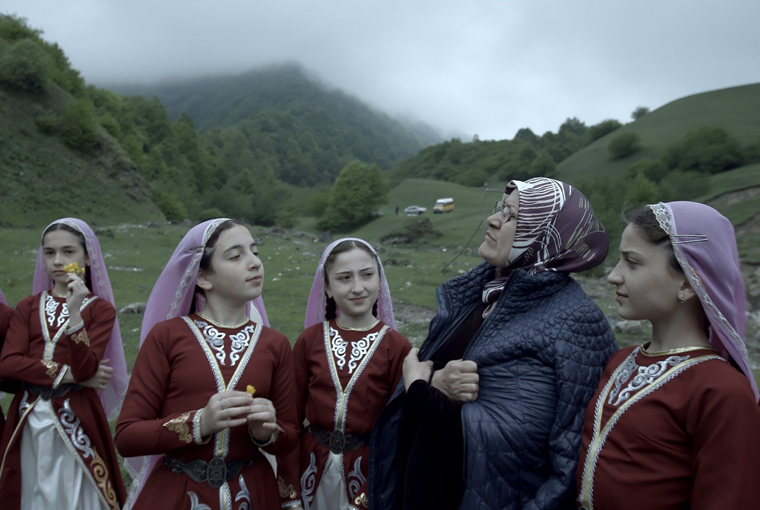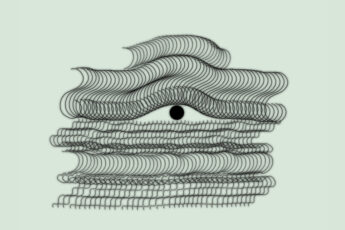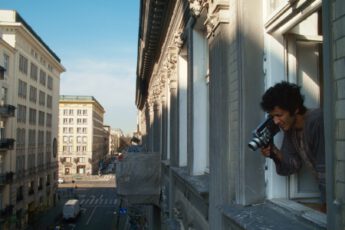Fairy-Tale Footage of Post-War Chechnya
Masha Novikova’s Daymohk (2019)
Vol. 106 (Summer 2020) by Patricia Bass
What was once my family is now owned by the President.”
– M. Novikova, director and narrator of Daymohk.
Within the first three minutes of Masha Novikova’s Daymohk, the director powerfully articulates the stakes of her documentary. Fifteen years ago, the Russian director stayed with the Ahmadovs in their small dark apartment, welcomed like a family member as she filmed their lives in the war-torn Chechen capital. Her 2019 documentary checks in on the family now that the war for independence is over and Chechnya is experiencing the uneasy peace of defeat.
Another director could easily cast the story of the Ahmadovs as a rags-to-riches fairy tale. Aminat Ahmadova, the teenage daughter with long blond hair, would be the princess. She is only reluctantly allowed to enter the eponymous children’s dance troupe her father founded, yet she quickly rises to become a national star, director of the troupe, and then director of the Chechen Philharmonic – as well as the third wife of pro-Russian Chechen leader Ramzan Kadyrov. Her father, choreographer Ramzan Ahmadov, was raised by parents exiled in 1944 who returned destitute to Chechnya in the 1950s. In 1999, from a landscape of bombings and war, he founded the Daymohk dance troupe which, within a few years, was touring Europe to international acclaim. Kadyrov made Daymohk a staple of national events and the Ahmadov family now resides in a spotless mansion, exclusively upholstered in white, with marble siding, Greek columns, and chandeliers in every room.
But Masha Novikova troubles the notion of a “happily ever after” with rich cinematography suggesting a rotten underbelly to this family’s wealth and this region’s peace. This is another sort of fairy tale, where the Ahmadovs pay for their new status with a spell of silence.
The early Ahmadov footage is bustling and warm, despite being filmed inside a small dark flat. Aminat wears her long blond hair tied at the nape of her neck with a scrunchie, and dresses up in a skirt, heels, and leather jacket to go out with her friends, while her mother, Aiza, reminisces, laughing, on how her own mother would tease her about how short she’d cut her own skirt. There is complicity and smiling. The present-day Ahmadov footage reveals the same women in demure floor-length gowns with covered hair and muted attitudes to match. Adult Aminat only rarely, if ever, speaks to the camera, and her mother evades questions about her daughter: in Chechnya, it is unseemly to brag about your offspring, she says. “God seems to have smiled upon Aminat”, is all she will tell us.
The camera lingers on their new possessions and makes compelling use of Kadyrov’s aggressive media presence. It repeatedly returns to the Ahmadovs’ blindingly-white living room, where a television blasts violent images of the Chechen leader demonstrating his sharp-shooting skills while a baby fusses in a crib lit by the flickering screen. Otherwise, Aiza and Ramzan are most frequently portrayed silently seated in their new palatial surroundings in footage overlaid with booming sound recordings of Kadryov ranting aggressive (and at times homophobic) political speeches. The camera focuses on family portraits, like a blown-up photograph of grandparents or a large painted portrait of Aminat draping her arms over the shoulders of her husband and political leader. The objects and the broadcasts tell a story that the subjects cannot.
Despite her initial statement about the Ahmadovs being “owned” by Kadyrov’s new pro-Putin regime, Novikova’s film demonstrates her discretion and her care for the family. She does not dwell on the violence that has rocked them in the past twenty years, although interview subjects make anecdotal mention of terrorist attacks and bombings. Ramzan Ahmadov, for example, is described crawling through the rubble of a performance hall attacked by terrorists, shaking each child dancer lying on the ground to check if they were alive. Certain words and gestures indicate that these experiences of violence touch the subjects further than they express in words.
Novikova focuses on how choreographer Ahmadov and leader Kadyrov each attempt to mobilize the children’s dance troupe to manifest their own visions of Chechen identity. Ahmadov makes a promotional dance video for his troupe to rekindle ties they’ve lost with Europe. He buries armor in an ancient Chechen tower, and Novikova films small boys in faux chain mail who “discover” it and begin to spar. A handful of elementary-age girls dressed in pristine gowns file across a bridge to swaddle the swords in their shawls, forcing a peace. “Chechens were a nation of knights”, says Ahmadov. For him, dance is about reconciliation, like the traditional Chechen practice of sword-swaddling.
Meanwhile, Kadyrov showcases Daymohk as the opening act for political and sporting events. In a particularly compelling scene, the children file into a cage in the center of an amphitheater lined with larger-than-life posters of Putin and Kadyrov. Moving spotlights from above strobe a confusing light show onto them and they dance as Kadyrov and his associates watch from velvet couches. The dance is followed by a boxing match between pre-pubescent boys, the headline event. If Ahmadov’s Chechen fairy tale is one of medieval chivalry and peace-making, Kadyrov’s is a militant celebration of physical strength.
If Ahmadov, who was proud of how Daymohk portrayed Chechen identity during the wars for Chechen independence, now permits the same dance group to perform at pro-Russian political events, does that make him, and the group, complicit in the new regime? Is the rags-to-riches tale of the Ahmadovs one of selling out? Novikova somewhat fatalistically portrays a world in which her subjects had no choice. The Aminats do not seem to take joy in their new wealth or titles, and events late in the film indicate that the famous choreographer struggles with depression and hopelessness in his new life. The filmmaker contrasts the omnipresent and inescapable political oppression with the dream-like beauty of Daymohk’s music video and a single spoken poem by Mikhail Lermontov, “the poet of the Caucasus”. But these forms of local culture and art are no escape, as they are just as vulnerable to Russian occupation as the Chechen region, and people, itself.




Leave a Comment